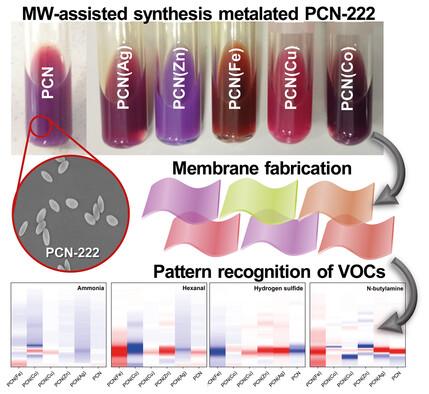构建透明膜的纳米级卟啉金属有机框架,用作多反应光学气体传感器
IF 11.1
Q1 MATERIALS SCIENCE, MULTIDISCIPLINARY
引用次数: 0
摘要
众所周知,卟啉具有出色的比色传感能力,而金属有机框架(MOF)又具有优异的结构特性,因此 PCN-222 等卟啉基 MOF 是构建基于吸光度的化学传感器的理想候选材料。然而,据作者所知,迄今为止还没有开发出高质量的卟啉基 MOF 气体传感器,这很可能是由于在以下方面存在困难:1) 制备纳米级的卟啉-MOFs 以减少吸光度测量中的散射;以及 2) 将 MOFs 集成到透明膜中以便实际使用。本文报告了一种简单快速的微波辅助方法,用于制备高质量的纳米级 PCN-222 晶体及其金属化衍生物 PCN-222(M),以微调传感响应。接下来,研究人员成功地将这些 PCN-222(M)纳米粒子分散到聚二甲基硅氧烷中,制成了柔性透明膜。这种集成方法产生了一种多反应光学气体传感器,它具有出色的灵敏度,并能通过模式识别辨别各种挥发性有机化合物。本文章由计算机程序翻译,如有差异,请以英文原文为准。

Nanosized Porphyrinic Metal–Organic Frameworks for the Construction of Transparent Membranes as a Multiresponsive Optical Gas Sensor
The well-known and excellent colorimetric sensing capacity of porphyrins, along with the exceptional structural properties of metal–organic frameworks (MOFs), make porphyrin-based MOFs, such as PCN-222, ideal candidates for the construction of a chemical sensor based on absorbance. However, to the best of authors’ knowledge, no high-quality porphyrin-based MOF gas sensors have been developed to date, most likely due to the difficulties in: 1) preparing nanosized porphyrin-MOFs to minimize scattering in absorbance measurements; and 2) incorporating MOFs into transparent membranes for practical use. Herein, a simple and fast microwave-assisted method for preparing high-quality nanosized PCN-222 crystals and their metalated derivatives PCN-222(M) is reported to finely tune the sensing response. Next, the successful dispersion of these PCN-222(M) nanoparticles into poly(dimethylsiloxane) to create flexible and transparent membranes is demonstrated. This integration yields a multiresponsive optical gas sensor exhibiting excellent sensitivity and the ability to discriminate between various volatile organic compounds via pattern recognition identification.
求助全文
通过发布文献求助,成功后即可免费获取论文全文。
去求助
来源期刊
CiteScore
14.00
自引率
2.40%
发文量
0
期刊介绍:
Small Science is a premium multidisciplinary open access journal dedicated to publishing impactful research from all areas of nanoscience and nanotechnology. It features interdisciplinary original research and focused review articles on relevant topics. The journal covers design, characterization, mechanism, technology, and application of micro-/nanoscale structures and systems in various fields including physics, chemistry, materials science, engineering, environmental science, life science, biology, and medicine. It welcomes innovative interdisciplinary research and its readership includes professionals from academia and industry in fields such as chemistry, physics, materials science, biology, engineering, and environmental and analytical science. Small Science is indexed and abstracted in CAS, DOAJ, Clarivate Analytics, ProQuest Central, Publicly Available Content Database, Science Database, SCOPUS, and Web of Science.

 求助内容:
求助内容: 应助结果提醒方式:
应助结果提醒方式:


